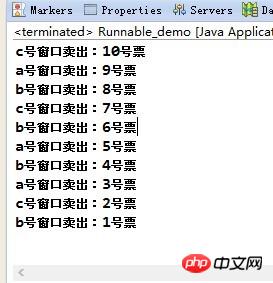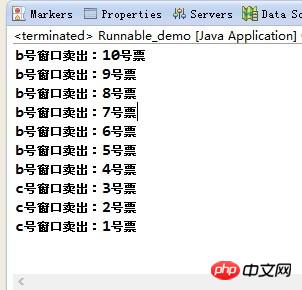Sample code sharing of Java synchronization lock (synchronized)
This article mainly introduces the detailed explanation and examples of Java synchronization lock (synchronized). Friends who need it can refer to
Java synchronization lock (synchronized) detailed explanation and examples
The time slice allocated by the CPU to each thread in Java is random, and many threads in Java share a resource. For example, when selling train tickets, the train ticket is certain, but the window for selling train tickets is It's everywhere. Each window is equivalent to a thread. So many threads share the resource of all train tickets. If two threads use this resource at the same time at one point in time, the train tickets they take out will be the same (same seat number), which will cause trouble for passengers. For example, the following program:
package com.pakage.ThreadAndRunnable;
public class Runnable_demo implements Runnable{
private int ticket=10;
public Runnable_demo(){
}
@Override
public void run() {
for(int i=0;i<20;i++){
if(this.ticket>0){
//休眠1s秒中,为了使效果更明显,否则可能出不了效果
try {
Thread.sleep(1000);
} catch (Exception e) {
e.printStackTrace();
}
System.out.println(Thread.currentThread().getName()+"号窗口卖出:"+this.ticket--+"号票");
}
}
}
public static void main(String args[]){
Runnable_demo demo=new Runnable_demo();
//基于火车票创建三个窗口
new Thread(demo,"a").start();
new Thread(demo,"b").start();
new Thread(demo,"c").start();
}
}Program running result:

We can see that both window C and window B have sold 10 Ticket number, and tickets numbered 0 and -1 were sold at windows a and b respectively. The reason for this situation is 1. When the c thread and the b thread have ticket=10, after the c thread takes out the ticket No. 10, the ticket has not yet come and is reduced by 1, and the b thread takes out the ticket. At this time, the ticket is still equal to 10. ; 2. When ticket=1, thread c takes out ticket No. 1. Before the ticket comes, it is decremented by 1. Threads a and b enter the ifjudgment statement successively. At this time, the ticket is decremented by 1. , then when threads a and b get tickets, they get tickets No. 0 and -1.
How to change the above situation? We can do this: When a thread wants to use the resource of train tickets, we give it a lock and wait for it to do the thing. After that, give the lock to another thread that wants to use this resource. In this way, the above situation will not occur. To implement this lock function, you need to use the synchronized keyword.
synchronized keyword has two uses1. Put it before the method name to form a synchronized method; 2. Put it before the block to form a synchronized block.
1. Use the synchronization method to change the above example to:
package com.pakage.ThreadAndRunnable;
public class Runnable_demo implements Runnable{
private int ticket=10;
public Runnable_demo(){
}
@Override
public void run() {
for(int i=0;i<20;i++){
if(this.ticket>0){
//休眠1s秒中,为了使效果更明显,否则可能出不了效果
try {
Thread.sleep(1000);
} catch (Exception e) {
e.printStackTrace();
}
this.sale();
}
}
}
public synchronized void sale(){
if(this.ticket>0){
System.out.println(Thread.currentThread().getName()+"号窗口卖出:"+this.ticket--+"号票");
}
}
public static void main(String args[]){
Runnable_demo demo=new Runnable_demo();
//基于火车票创建三个窗口
new Thread(demo,"a").start();
new Thread(demo,"b").start();
new Thread(demo,"c").start();
}
}The output result of the program is:

2. Use synchronization block to modify the above example:
package com.pakage.ThreadAndRunnable;
public class Runnable_demo implements Runnable{
private int ticket=10;
public Runnable_demo(){
}
@Override
public void run() {
for(int i=0;i<20;i++){
<span style="color:#ff0000">synchronized</span>(this){
if(this.ticket>0){
//休眠1s秒中,为了使效果更明显,否则可能出不了效果
try {
Thread.sleep(1000);
} catch (Exception e) {
e.printStackTrace();
}
System.out.println(Thread.currentThread().getName()+"号窗口卖出:"+this.ticket--+"号票");
}
}
}
}
public static void main(String args[]){
Runnable_demo demo=new Runnable_demo();
//基于火车票创建三个窗口
new Thread(demo,"a").start();
new Thread(demo,"b").start();
new Thread(demo,"c").start();
}
}The output result of the program:

The above is the detailed content of Sample code sharing of Java synchronization lock (synchronized). For more information, please follow other related articles on the PHP Chinese website!

Hot AI Tools

Undresser.AI Undress
AI-powered app for creating realistic nude photos

AI Clothes Remover
Online AI tool for removing clothes from photos.

Undress AI Tool
Undress images for free

Clothoff.io
AI clothes remover

Video Face Swap
Swap faces in any video effortlessly with our completely free AI face swap tool!

Hot Article

Hot Tools

Notepad++7.3.1
Easy-to-use and free code editor

SublimeText3 Chinese version
Chinese version, very easy to use

Zend Studio 13.0.1
Powerful PHP integrated development environment

Dreamweaver CS6
Visual web development tools

SublimeText3 Mac version
God-level code editing software (SublimeText3)

Hot Topics
 1655
1655
 14
14
 1413
1413
 52
52
 1306
1306
 25
25
 1252
1252
 29
29
 1226
1226
 24
24
 Break or return from Java 8 stream forEach?
Feb 07, 2025 pm 12:09 PM
Break or return from Java 8 stream forEach?
Feb 07, 2025 pm 12:09 PM
Java 8 introduces the Stream API, providing a powerful and expressive way to process data collections. However, a common question when using Stream is: How to break or return from a forEach operation? Traditional loops allow for early interruption or return, but Stream's forEach method does not directly support this method. This article will explain the reasons and explore alternative methods for implementing premature termination in Stream processing systems. Further reading: Java Stream API improvements Understand Stream forEach The forEach method is a terminal operation that performs one operation on each element in the Stream. Its design intention is
 PHP: A Key Language for Web Development
Apr 13, 2025 am 12:08 AM
PHP: A Key Language for Web Development
Apr 13, 2025 am 12:08 AM
PHP is a scripting language widely used on the server side, especially suitable for web development. 1.PHP can embed HTML, process HTTP requests and responses, and supports a variety of databases. 2.PHP is used to generate dynamic web content, process form data, access databases, etc., with strong community support and open source resources. 3. PHP is an interpreted language, and the execution process includes lexical analysis, grammatical analysis, compilation and execution. 4.PHP can be combined with MySQL for advanced applications such as user registration systems. 5. When debugging PHP, you can use functions such as error_reporting() and var_dump(). 6. Optimize PHP code to use caching mechanisms, optimize database queries and use built-in functions. 7
 PHP vs. Python: Understanding the Differences
Apr 11, 2025 am 12:15 AM
PHP vs. Python: Understanding the Differences
Apr 11, 2025 am 12:15 AM
PHP and Python each have their own advantages, and the choice should be based on project requirements. 1.PHP is suitable for web development, with simple syntax and high execution efficiency. 2. Python is suitable for data science and machine learning, with concise syntax and rich libraries.
 PHP vs. Other Languages: A Comparison
Apr 13, 2025 am 12:19 AM
PHP vs. Other Languages: A Comparison
Apr 13, 2025 am 12:19 AM
PHP is suitable for web development, especially in rapid development and processing dynamic content, but is not good at data science and enterprise-level applications. Compared with Python, PHP has more advantages in web development, but is not as good as Python in the field of data science; compared with Java, PHP performs worse in enterprise-level applications, but is more flexible in web development; compared with JavaScript, PHP is more concise in back-end development, but is not as good as JavaScript in front-end development.
 PHP vs. Python: Core Features and Functionality
Apr 13, 2025 am 12:16 AM
PHP vs. Python: Core Features and Functionality
Apr 13, 2025 am 12:16 AM
PHP and Python each have their own advantages and are suitable for different scenarios. 1.PHP is suitable for web development and provides built-in web servers and rich function libraries. 2. Python is suitable for data science and machine learning, with concise syntax and a powerful standard library. When choosing, it should be decided based on project requirements.
 Java Program to Find the Volume of Capsule
Feb 07, 2025 am 11:37 AM
Java Program to Find the Volume of Capsule
Feb 07, 2025 am 11:37 AM
Capsules are three-dimensional geometric figures, composed of a cylinder and a hemisphere at both ends. The volume of the capsule can be calculated by adding the volume of the cylinder and the volume of the hemisphere at both ends. This tutorial will discuss how to calculate the volume of a given capsule in Java using different methods. Capsule volume formula The formula for capsule volume is as follows: Capsule volume = Cylindrical volume Volume Two hemisphere volume in, r: The radius of the hemisphere. h: The height of the cylinder (excluding the hemisphere). Example 1 enter Radius = 5 units Height = 10 units Output Volume = 1570.8 cubic units explain Calculate volume using formula: Volume = π × r2 × h (4
 PHP's Impact: Web Development and Beyond
Apr 18, 2025 am 12:10 AM
PHP's Impact: Web Development and Beyond
Apr 18, 2025 am 12:10 AM
PHPhassignificantlyimpactedwebdevelopmentandextendsbeyondit.1)ItpowersmajorplatformslikeWordPressandexcelsindatabaseinteractions.2)PHP'sadaptabilityallowsittoscaleforlargeapplicationsusingframeworkslikeLaravel.3)Beyondweb,PHPisusedincommand-linescrip
 PHP: The Foundation of Many Websites
Apr 13, 2025 am 12:07 AM
PHP: The Foundation of Many Websites
Apr 13, 2025 am 12:07 AM
The reasons why PHP is the preferred technology stack for many websites include its ease of use, strong community support, and widespread use. 1) Easy to learn and use, suitable for beginners. 2) Have a huge developer community and rich resources. 3) Widely used in WordPress, Drupal and other platforms. 4) Integrate tightly with web servers to simplify development deployment.




